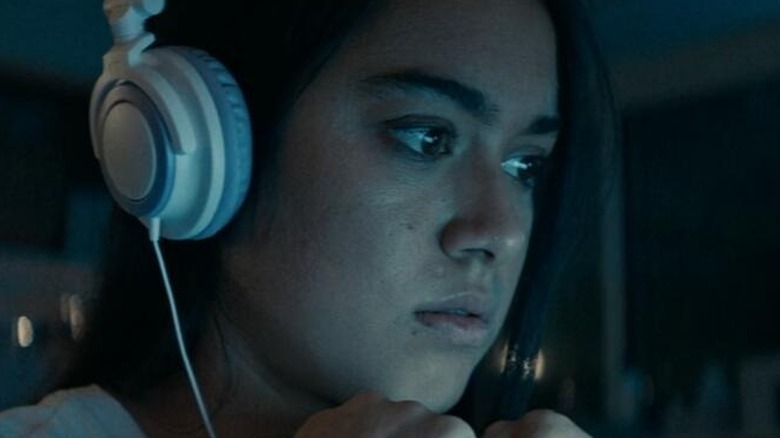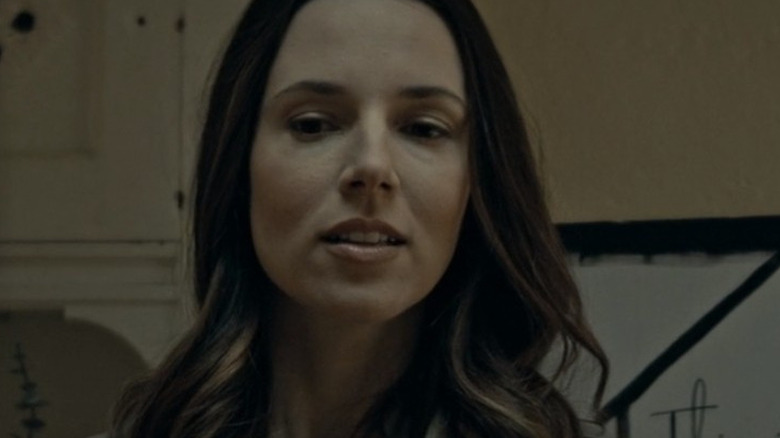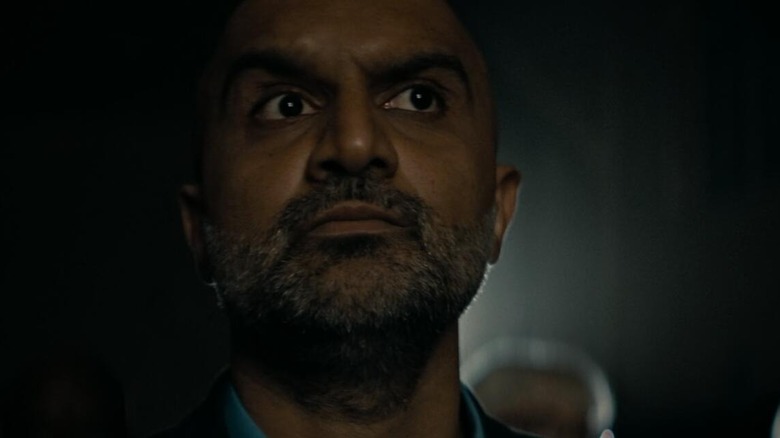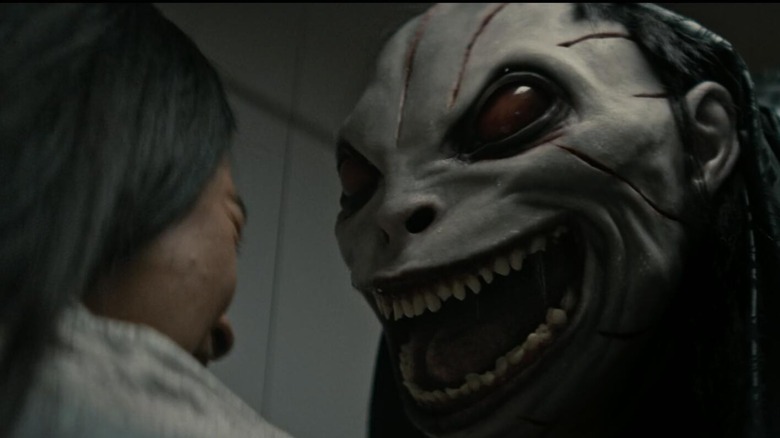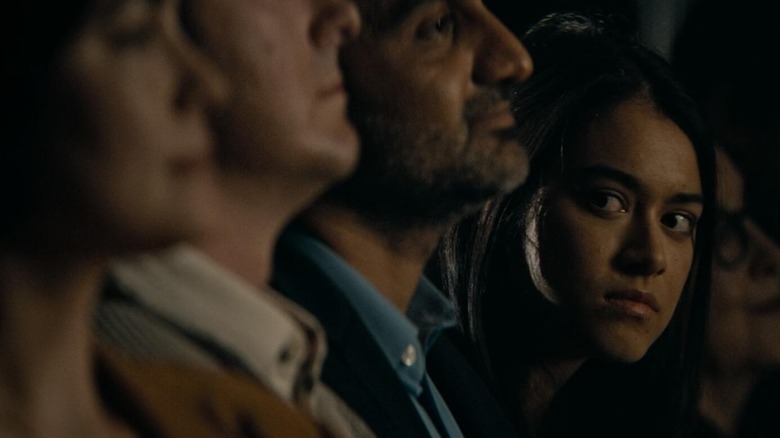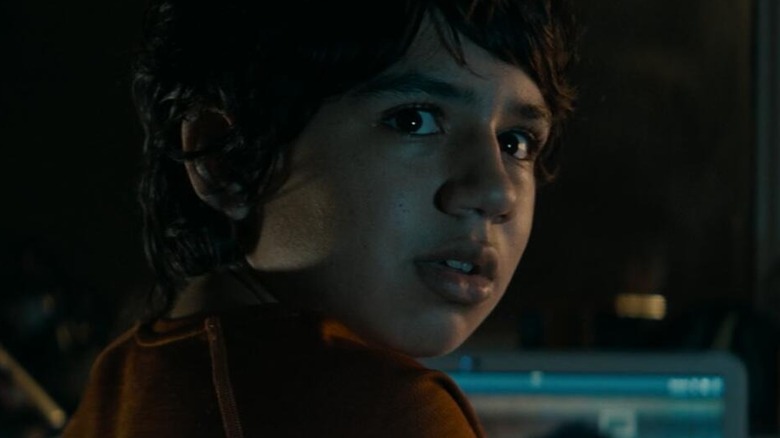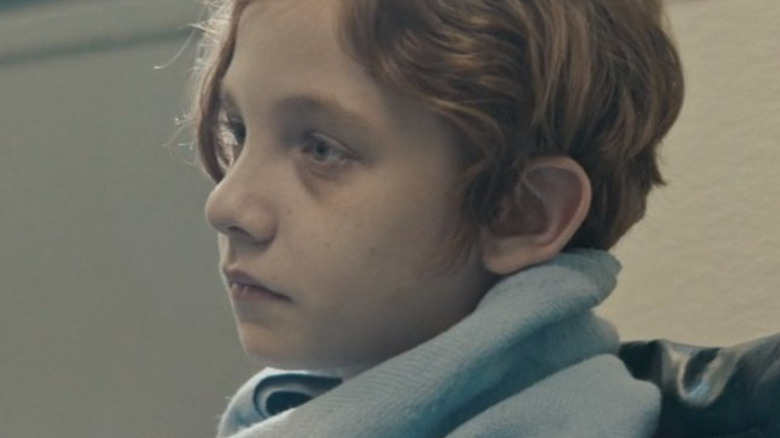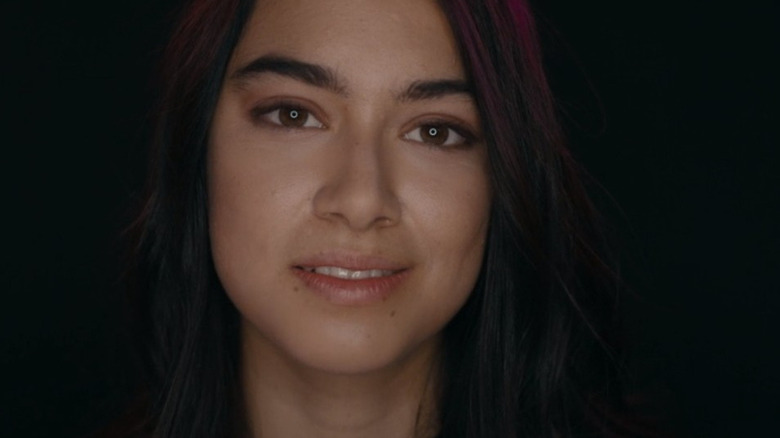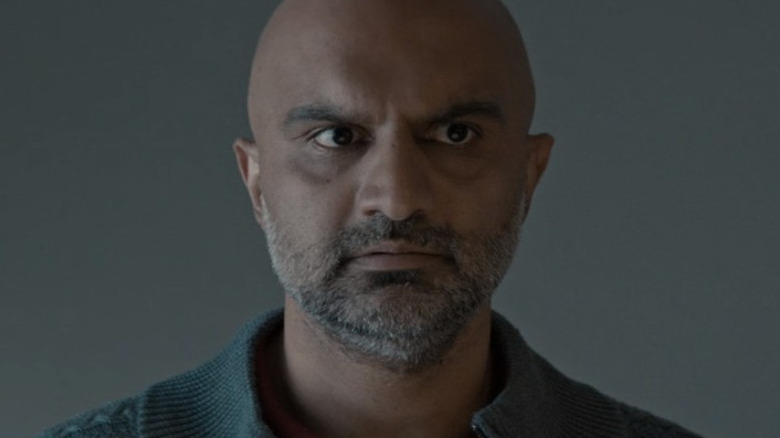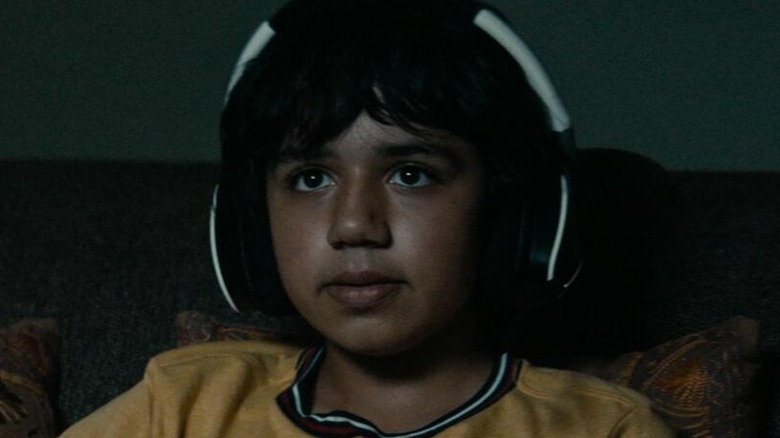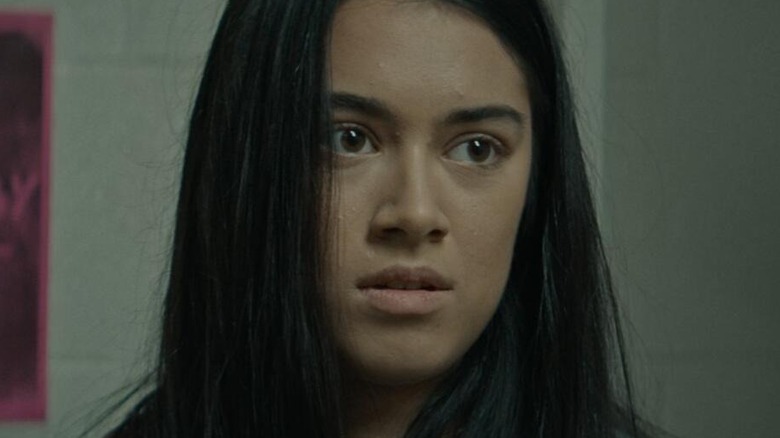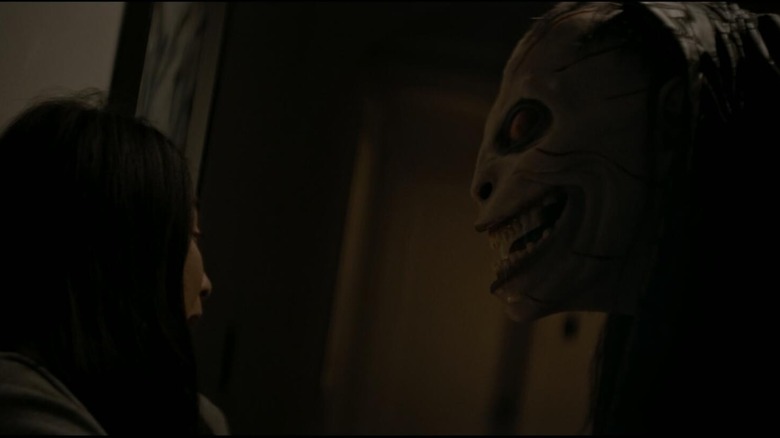The Ending Of Grimcutty Explained
Hulu's lineup of exclusive horror movies continues to grow with "Grimcutty," a tense flick that follows teen Asha (Sara Wolfkind), desperately trying to prove an internet challenge isn't real. As her parents Leah (Shannyn Sossamon) and Amir (Usman Ally) grow increasingly concerned about the Grimcutty — a challenge that purportedly asks teens to hurt themselves — the figure only becomes more real. With an uncanny face and enormous red eyes, the Grimcutty is a sight to behold, especially when it is dangling your child in the air.
As the movie progresses, Asha and her brother Kamran (Callan Farris) try to prove to their parents that they are the reason the monster appears, not because they are doing anonymous challenges online. Their parents, in an effort to protect their children from the presumed threat, take away their internet access and even try to keep Asha from going to school so she isn't in harm's way.
By the end, it's clear to Asha what causes the Grimcutty to appear, but her parents remain oblivious for far too long. There is a bit more to the Grimcutty, however; the movie's ending, in particular, boasts more than meets the eye. Below, a (spoiler-heavy) breakdown of everything revealed — and what it means for Asha, Kamran, Leah, and Amir.
Who started the Grimcutty craze?
Seemingly overnight, town parents have grown frantic about "The Grimcutty," a supposed internet challenge — albeit, one unknown to their children. Reading a blog post warning parents about the supposed craze, and what the challenge could "force" their children to do, the kids congregate on Snapchat, asking if anyone knows what the adults are talking about.
The blog post that everyone is getting their information from has been composed by local family blogger Melinda Jaynes (Alona Tal). She posts different family-related content (like how she handles certain situations with her child) and in the case of the Grimcutty, she advises parents to be on the lookout, sharing a picture of the monster's face. Her blog also touts a so-called "Detox Box," a safe-like device where parents can lock away the electronic devices of their children.
When Asha tracks Melinda down at home and confronts her, it is revealed that she discovered the Grimcutty, and it almost hurt her child. She wrote the post to try and inform others, hoping to save them from the being who hurt her son Brandon (Kayden Alexander Koshelev). The cry for caution backfires, however, after so many people read her blog post that it results in a Grimcutty inferno of sorts, bringing it to homes everywhere.
To try and counteract this, she deletes the blog post. But it is too late; the damage has already been done.
The parents bring the Grimcutty to life
Despite what the local parents believe, the Grimcutty isn't out there, waiting to find an innocent child through the latest messaging app or chat room. As it turns out, the monster is only brought to life when the parents begin to worry about it.
So, as these parents continue to become more and more concerned about their children completing internet challenges, it reinvigorates the Grimcutty, making it more alive as it goes from quick flashes to a fully corporeal being that can physically interact with its environment.
Parental suspicions of the Grimcutty, of course, mirror similar phenomena of the internet age, and even predating it. In recent years, things like Slenderman, the Blue Whale challenge and the Momo Challenge took on a cryptic life of their own, with parents warned that their children may participate in a challenge that encouraged them to hurt themselves. Even before the internet, there were so-called "urban legends" about everything from the Satanic Panic to flashing headlights gang initiations to poisoned Halloween candy, all resulting in sleepless nights for parents and little evidence to back any of it up. "The Grimcutty" writer/director John Ross, it seems, has crafted an amalgam of these, seasoned with a heavy dash of headline-grabbing fads in the spirit of the kids-in-the-street fears following "The Program," the Cinnamon Challenge, and others often spread via TikTok.
In the reality of this film, however, the Grimcutty is real. At least Momo was only a sculpture.
They found a way to stop the Grimcutty
Since parental concern is what brought the Grimcutty to life, they also have the ability to make it disappear. However, the parents have to get to a certain point in their own personal belief system for that to happen, which includes calming themselves down when their worries get particularly strong.
When Asha confronts the blogger, her mother tracks down where she is. As she arrives, her emotions are uncontrollable. She's concerned about her daughter's mental well-being, why she is stealing cars to go to a random person's house, and how this stranger is treating their son. As Asha tries to explain what's going on, Leah hits a wall, choosing to slap Asha in anger. As they're getting in the car, her mother reaches a breaking point. Asha is trying to tell her she's feeding the monster, begging her to "chill" as the Grimcutty gets closer and closer.
Leah breaks the driver's side window of the car, which seems to bring her down amid the realization that self-composure is key. After they arrive at the hospital, she gives her husband a shot that will help him calm down, which he uses as he watches Asha being suspended in midair, the Grimcutty holding her by the throat.
The parents realize denial only causes more harm
When Leah calms down, she seems to realize that her denial of the situation (and what Asha is saying) is contributing to the pain her family is going through. Asha tries telling her parents repeatedly that she doesn't know what they are talking about, but also that, since they brought it up, she's seen it and it is trying to hurt her. They brush her off. In a classic horror movie tradition dating all the way back to Steve McQueen in "The Blob," so too do the police and every other adult she attempts to warn.
By the end of the movie, her parents realize that if only they had listened to her, the Grimcutty attacks never would have happened. By blindly following a family blog and allowing it to instill fear in them, they've hurt their family; they realize the error of their ways just in the nick of time.
However, the other parents only stop worrying because Asha's parents set the example. They share their story and what happened, and the other adults believe them, not their children, who say the entire time that they don't know what the Grimcutty challenge is. It's disappointing that it took other adults telling them to break the hysteria, but it also isn't surprising that parents didn't want to listen to their kids.
While "Grimcutty" depicts this all through the lens of an internet challenge, parents in denial of what their children are going through is, unfortunately, timeless. "The Grimcutty" simply dramatizes the extremes to which it can hurt a family.
Listening is a two-way street
As Asha reminds everyone in her final video, listening goes both ways. While she begs her parents to listen to her, she also needs to listen to their concerns and why they worry. To her, it all comes across as a way for her parents to control her media use, especially since they feel she has been different since she quit the track team. But, Asha is exploring a new passion, making ASMR videos. It seems there was miscommunication on both ends.
When her parents decide to use the "Detox Box," they don't necessarily explain what's going on, but Asha also doesn't listen to their goal. They aren't trying to make their children miserable; they want them to have a tech-free week to see how it impacts their mood, presumably for the better. Nevertheless, her parents don't listen when she expresses why she is on her phone, what she does, and why that makes her happy.
"Grimcutty" gives a look into how miscommunication, combined with fear, can poison a family dynamic. Listening is one of the keys to stopping the Grimcutty; if they listened sooner, they would have saved themselves worry, fear, and multiple near-death experiences.
The blogger faced her consequences
After Asha's mother goes back into Melinda's house, she discovers Brandon's state when the Grimcutty tries to attack him. It's clear that the boy is living in less-than-ideal conditions, locked in a room. He's lethargic, collapsing on the floor after hurting his mother to save Leah and Asha.
Asha discovers that all electronic devices, even a computer keyboard, are damaged and thrown away. As she enters the home, she finds Brandon's room, which has two chain locks on the outside, preventing him from leaving. Melinda locks her child in his closet. As Asha opens the closet door, he falls out, half-asleep and dazed. It's implied that Melinda has done these things to keep the Grimcutty away from her son.
The boy goes to the hospital after Leah and Melinda's almost-showdown. Melinda leaves in an ambulance, but the handcuffs around her wrists reveal that she isn't going to the hospital as a free person. When audiences see Brandon again at the end of the movie, he is in a wheelchair, gaunt and sporting sunken eyes. It's clear he's been through something horrible, and that he lived in the closet for an extended period of time before Asha found him, but at least his mother will (likely) be held accountable for her actions.
Asha used the tragedy to build her platform
When audiences meet Asha, she's working on her YouTube channel. She creates ASMR content of things being softly run over by a car, making soothing noises to which people enjoy listening. She doesn't have many followers or viewers, but she seems to enjoy making the content. Throughout the film, she takes moments to listen to the world around her to calm down, using ASMR as something therapeutic in her own life.
At the end of "Grimcutty," she records an ASMR video of her whispering, answering questions about the Grimcutty and her family's experience. She explains what happened, and that despite everything they've gone through, she and her family made it out on the other side. She says "it's pretty messed up" what they experienced, but she encourages her viewers not to worry.
In her video, she notes that what she's recording isn't her usual content; the number of questions on her videos about the Grimcutty caused her to make a video answering them. It's evident that, at the very least, her channel received an influx of activity due to her family's experience with the Grimcutty.
The parents need to check their sources
"Grimcutty" offers a reminder that not only parents, but everyone, needs to be careful about believing what they read online.
Leah and Amir become obsessed with the Grimcutty, to the point where they put their children's lives in grave danger. Having blind faith in the information a single blog post provides is nearly their downfall; the monster isn't something multiple blogs are posting about, at least not until the news picks up the stories about children reportedly hurting themselves. Rather than continuing to research and see if others are reporting on the supposed internet challenge, they take Melinda's word as the ultimate truth.
By the end of the film, Asha's parents have a better understanding of how they can support their children and keep them safe. While the audience doesn't see them blow the lid off the Grimcutty craze, Asha tells us it happens. With any luck, not only have the parents become better listeners, but also better researchers.
Not everything can be blamed on technology
The knee-jerk reaction of most of the parents in "Grimcutty" is to take away their children's devices, attempting to shield them from the dangers of the outside world. If it could connect to the internet, many of them believed, it needed to be locked away — often in the "Detox Box" that Melinda posts about on her blog, using her words verbatim to explain to their children why the family was revoking internet privileges.
But the parents grow to realize that technology is not what causes the Grimcutty to appear, and it isn't what is harming their families. With Asha making ASMR videos by the end of the film, it's clear that she was allowed back on the internet. Despite their efforts to force children into a social media blackout, the Grimcutty persisted. The lesson here would seem to be that while technology has changed the way we live our lives, it can be helpful or hurtful, largely depending on the actions of those who use it.
Be careful what you get wrapped up in
The Grimcutty isn't simply a parable about internet challenges; it also takes aim at the dark side of so-called "family" blogs.
The family blogging and vlogging industry exploded in popularity about a decade ago and continues to thrive, particularly as "family channels" have become prevalent on YouTube. While some of these blogs can offer solid advice for parents on topics like breastfeeding, bonding, play dates, and getting your picky eater to try spinach, they can also cause parents to hyper-focus on things that could be detrimental to their children.
In "Grimcutty," the blog causes families to become paranoid about a purported internet challenge; as readers dig further into Melinda's posts in an effort to protect their children, the paranoia and suspicion only multiplies. This hyper-focus becomes what drives the monster; Melinda goes overboard in her desire to protect her son, and that same type of reaction nearly manifests itself in Asha and her friends' parents, even if that isn't Melinda's intention.
Grimcutty isn't gone for good
While the parents in Asha's area are no longer concerned about the Grimcutty by the end of the film, that doesn't mean the internet monster is gone for good. All it took was a single blogger to start the mass hysteria, causing immense harm. That could happen again, anytime somebody is uploading new content.
In Asha's ASMR video, she discusses that all it would take is another blogger or over-involved parent to get wind of the Grimcutty and start the cycle all over. While Melinda took down her blog post, there were still news reports and other sources reporting on the "challenge," and that could make other parents scared and start the entire cycle all over again. The adults in Asha's town seem to have it under control — for now — but the same cannot be said for the rest of the world.
